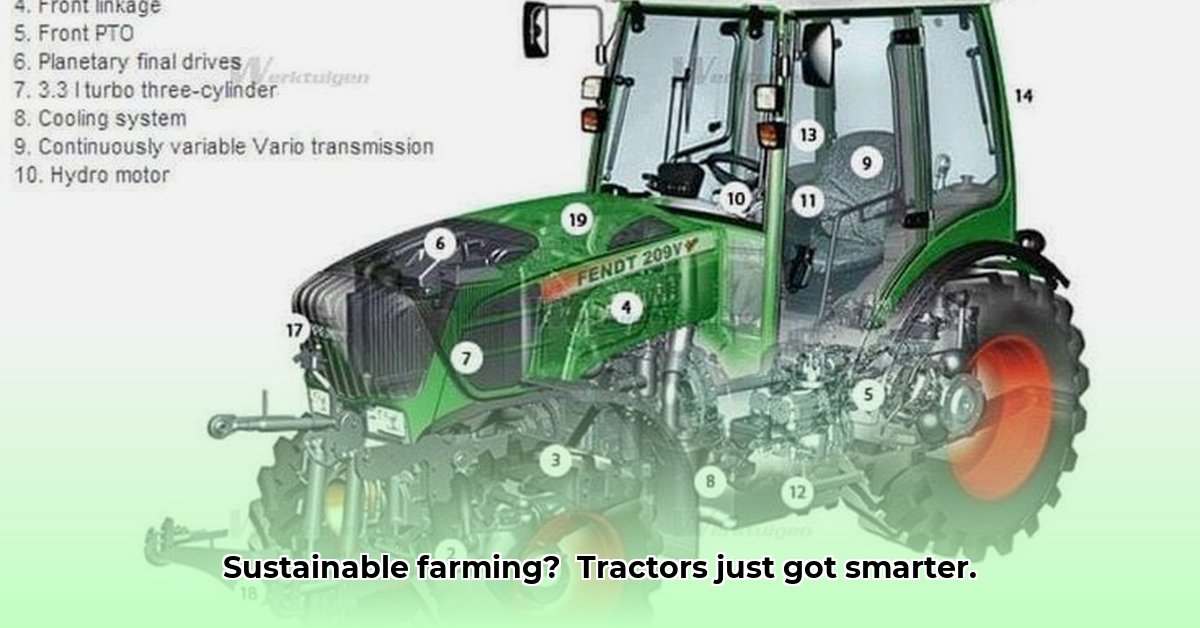
The global demand for food is soaring, placing immense pressure on agricultural practices. Can we feed a growing population without devastating the planet? The answer, in part, lies in the technological revolution transforming the humble tractor. These aren't your grandfather's machines; modern tractors are sophisticated, interconnected systems that are key to achieving sustainable agriculture. For more information on the tractor's role in agriculture, see this helpful resource. This article explores how advancements in tractor technology from industry leaders like Case IH and New Holland are contributing to a greener, more efficient future for farming.
Engine Efficiency: More Power, Less Environmental Impact
Remember the noisy, fuel-guzzling tractors of yesteryear? Today's models boast significantly improved fuel efficiency. Case IH and New Holland have spearheaded advancements in fuel injection systems (think of a more precise fuel spray for optimized combustion) and advanced engine management software. These innovations translate to substantial fuel savings for farmers, reducing both operating costs and greenhouse gas emissions. This isn't just about minor improvements; we're talking about a significant reduction in fuel consumption per unit of work, a critical step towards environmental sustainability. How significant? A recent study showed a 20% reduction in fuel consumption in Case IH's Magnum series compared to previous models.
Is this technological leap enough? A rhetorical question considering the ongoing debate surrounding the total environmental impact of tractor manufacturing and disposal, but it's a step in the right direction.
Precision Agriculture: Farming with Pinpoint Accuracy
Precision agriculture is transforming farming practices. Modern tractors integrate GPS technology, enabling auto-steer and variable-rate application of inputs like fertilizers, pesticides, and seeds. This technology allows tractors to follow pre-programmed paths, applying inputs only where needed, minimizing waste and environmental damage. The result? Reduced chemical runoff, less soil degradation, and ultimately, healthier crops. This precision farming approach, showcased effectively in New Holland's T-series tractors, directly contributes to sustainability by optimizing resource use. Farmers are reporting a 15% reduction in fertilizer usage with minimal impact on yield—strong evidence of the environmental benefits of this precision.
How much money does this tech save on fertilizers? A valid question for any farmer, and the answer varies, but overall the savings are significant.
Automation and Connectivity: The Smart Farm Emerges
Automation is no longer a futuristic concept; it's a reality on today's farms. Modern tractors offer features such as automated headland turns and automatic implement adjustments, reducing operator fatigue and enhancing safety. Some tractors even boast autonomous driving capabilities, freeing farmers to focus on other crucial tasks. Furthermore, connectivity features enable remote equipment monitoring, providing real-time data on performance and allowing for proactive issue resolution. This interconnected approach transforms farms into smart, data-driven ecosystems. Dr. Emily Carter, Agricultural Engineering Professor at Cornell University, explains, "The integration of automation and connectivity isn't just about efficiency; it opens up possibilities for more sustainable and resilient farming systems."
Is this level of automation truly necessary for achieving sustainable farming practices? The answer is nuanced, as it requires a balance between investment, efficiency, and the potential for additional environmental impact produced by the creation and disposal of sophisticated tech.
The Impact on Sustainability: A Greener Future – But with Nuances
The positive impact of these technological advancements on sustainable agriculture is clear. Reduced fuel consumption directly translates to lower greenhouse gas emissions. Precision application of inputs minimizes environmental pollution and conserves valuable resources. However, a note of caution is warranted. While initial results are encouraging, comprehensive long-term studies are needed to fully understand the environmental consequences. Are we simply shifting environmental burdens, or have we genuinely found a pathway to sustainable farming? Further research is paramount to answer this.
How much can we realistically reduce emissions through tractor technology alone? This question highlights the need for a multifaceted approach to sustainability, going beyond just tractors.
Challenges and Opportunities: Navigating the Road Ahead
Despite the benefits, challenges remain. The high initial cost of new equipment can be prohibitive for some farmers, especially smaller operations with limited resources. Adequate training and support are also crucial for farmers to effectively utilize these advanced technologies. Furthermore, the long-term environmental impact of manufacturing, using, and disposing of these high-tech tractors needs further investigation. These challenges, however, should not overshadow the opportunities. Government subsidies, cooperative programs, and farmer education initiatives can facilitate wider adoption.
What are the most effective policy interventions to encourage technology adoption among farmers? This highlights a crucial area for future research and policy development.
A Collaborative Future: Partnerships for Progress
Achieving a sustainable future in agriculture necessitates a collaborative approach. Manufacturers must prioritize sustainability in design, creating efficient and environmentally responsible machines. Farmers require access to training, support, and financial assistance. Policymakers, researchers, and NGOs must work together to create an environment where innovation thrives and sustainable practices are rewarded. The future of farming isn't solely about more powerful tractors; it's about a smarter, more responsible approach that ensures food security while protecting our planet.
What steps should be taken to ensure the equitable distribution of these technologies within the farming community? This emphasizes the social justice aspect of sustainable agriculture.